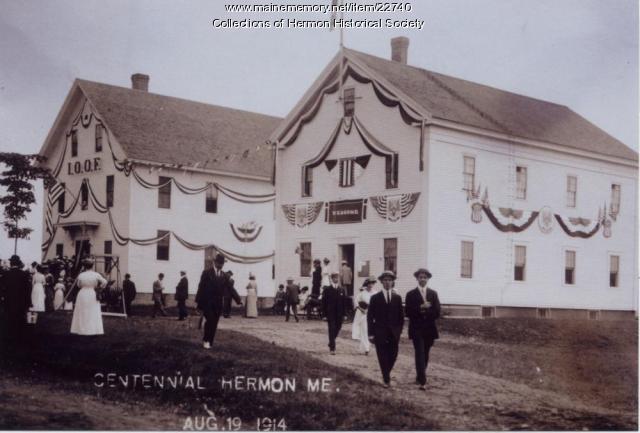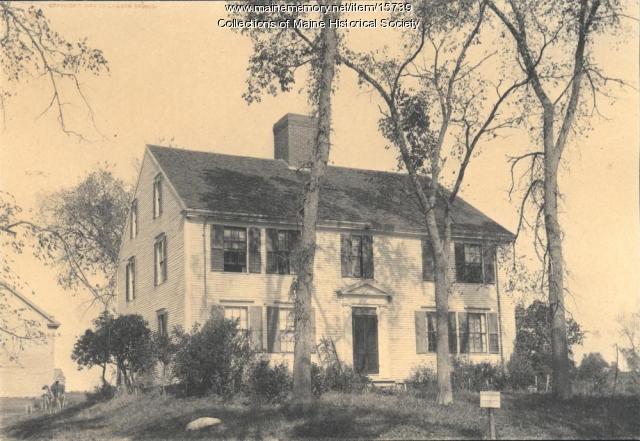Keywords: art student
- Historical Items (337)
- Tax Records (0)
- Architecture & Landscape (5)
- Online Exhibits (49)
- Site Pages (96)
- My Maine Stories (7)
- Lesson Plans (38)
Lesson Plans
Your results include these lesson plans. Your results include these lesson plans.
Lesson Plan
Maine's Acadian Community: "Evangeline," Le Grand Dérangement, and Cultural Survival
Grade Level: 9-12
Content Area: English Language Arts, Social Studies
This lesson plan will introduce students to the history of the forced expulsion of thousands of people from Acadia, the Romantic look back at the tragedy in Henry Wadsworth Longfellow's famous epic poem Evangeline and the heroine's adoption as an Acadian cultural figure, and Maine's Acadian community today, along with their relations with Acadian New Brunswick and Nova Scotia residents and others in the Acadian Diaspora. Students will read and discuss primary documents, compare and contrast Le Grand Dérangement to other forced expulsions in Maine history and discuss the significance of cultural survival amidst hardships brought on by treaties, wars, and legislation.
Lesson Plan
Grade Level: 3-5, 6-8, 9-12
Content Area: Science & Engineering, Social Studies
This lesson plan will give middle and high school students a broad overview of the ash tree population in North America, the Emerald Ash Borer (EAB) threatening it, and the importance of the ash tree to the Wabanaki people in Maine. Students will look at Wabanaki oral histories as well as the geological/glacial beginnings of the region we now know as Maine for a general understanding of how the ash tree came to be a significant part of Wabanaki cultural history and environmental history in Maine. Students will compare national measures to combat the EAB to the Wabanaki-led Ash Task Force’s approaches in Maine, will discuss the benefits and challenges of biological control of invasive species, the concept of climigration, the concepts of Traditional Ecological Knowledge (TEK) and Indigenous Knowledge (IK) and how research scientists arrive at best practices for aiding the environment.
Lesson Plan
Building Community/Community Buildings
Grade Level: 6-8
Content Area: Social Studies
Where do people gather? What defines a community? What buildings allow people to congregate to celebrate, learn, debate, vote, and take part in all manner of community activities? Students will evaluate images and primary documents from throughout Maine’s history, and look at some of Maine’s earliest gathering spaces and organizations, and how many communities established themselves around certain types of buildings. Students will make connections between the community buildings of the past and the ways we express identity and create communities today.
Lesson Plan
Portland History: Signalizing and Non-Verbal Communications at the Portland Observatory
Grade Level: 3-5
Content Area: English Language Arts, Social Studies, Visual & Performing Arts
This lesson is an overview of Captain Lemuel Moody's (builder of the Observatory) signaling system used at the Portland Observatory. Activities range from flag making to mapping and journal writing. The "Signals" slide show allows students to look at Captain Moody's general and private signals notebooks. Students are asked a series of questions about the notebooks and Moody's signaling system allowing for a better understanding of the principles behind the Observatory.
Lesson Plan
Longfellow Studies: The Village Blacksmith - The Reality of a Poem
Grade Level: 6-8, 9-12
Content Area: English Language Arts, Social Studies
"The Village Blacksmith" was a much celebrated poem. Written by Henry Wadsworth Longfellow, the poem appeared to celebrate the work ethic and mannerisms of a working man, the icon of every rural community, the Blacksmith. However, what was the poem really saying?
Lesson Plan
Longfellow Studies: Longfellow Amongst His Contemporaries - The Ship of State DBQ
Grade Level: 9-12
Content Area: English Language Arts, Social Studies
Preparation Required/Preliminary Discussion:
Lesson plans should be done in the context of a course of study on American literature and/or history from the Revolution to the Civil War.
The ship of state is an ancient metaphor in the western world, especially among seafaring people, but this figure of speech assumed a more widespread and literal significance in the English colonies of the New World. From the middle of the 17th century, after all, until revolution broke out in 1775, the dominant system of governance in the colonies was the Navigation Acts. The primary responsibility of colonial governors, according to both Parliament and the Crown, was the enforcement of the laws of trade, and the governors themselves appointed naval officers to ensure that the various provisions and regulations of the Navigation Acts were executed. England, in other words, governed her American colonies as if they were merchant ships.
This metaphorical conception of the colonies as a naval enterprise not only survived the Revolution but also took on a deeper relevance following the construction of the Union. The United States of America had now become the ship of state, launched on July 4th 1776 and dedicated to the radical proposition that all men are created equal and endowed with certain unalienable rights. This proposition is examined and tested in any number of ways during the decades between the Revolution and the Civil War. Novelists and poets, as well as politicians and statesmen, questioned its viability: Whither goes the ship of state? Is there a safe harbor somewhere up ahead or is the vessel doomed to ruin and wreckage? Is she well built and sturdy or is there some essential flaw in her structural frame?
Lesson Plan
Longfellow Studies: The Elms - Stephen Longfellow's Gorham Farm
Grade Level: 6-8, 9-12
Content Area: English Language Arts, Social Studies
On April 3, 1761 Stephen Longfellow II signed the deed for the first 100 acre purchase of land that he would own in Gorham, Maine. His son Stephen III (Judge Longfellow) would build a home on that property which still stands to this day. Judge Longfellow would become one of the most prominent citizens in Gorhams history and one of the earliest influences on his grandson Henry Wadsworth Longfellow's work as a poet.
This exhibit examines why the Longfellows arrived in Gorham, Judge Longfellow's role in the history of the town, Henry Wadsworth Longfellow's vacations in the country which may have influenced his greatest work, and the remains of the Longfellow estate still standing in Gorham today.
Lesson Plan
Portland History: Construction, Preservation and Restoration of the Portland Observatory
Grade Level: 3-5, 6-8
Content Area: Science & Engineering, Social Studies
Included here are activities based in economics, mathematics, physics, social studies, civics and language arts. Students can debate the issues surrounding preservation and urban development as well as the changing value of money.
Lesson Plan
Grade Level: 6-8, 9-12, Postsecondary
Content Area: Science & Engineering, Social Studies
This lesson presents an overview of the history of the fur trade in Maine with a focus on the 17th and 18th centuries, on how fashion influenced that trade, and how that trade impacted Indigenous peoples and the environment.
Lesson Plan
Grade Level: 6-8, 9-12, Postsecondary
Content Area: Social Studies
This lesson presents an overview of the history of Jews in Maine and the U.S., including some of the factors that led to Jewish immigration to the U.S., examination of the prejudice, discrimination and anti-Semitism many Jews have experienced, and the contributions of Jews to community life and culture in Maine.
Lesson Plan
Grade Level: 6-8, 9-12, Postsecondary
Content Area: Social Studies
This lesson presents an overview of the history of the LGBTQ community in Maine and the U.S., including the ways in which attitudes towards the LGBTQ community have changed over time, some of the ways LGBTQ people have faced discrimination and unfair treatment, and some of the moments in Maine and U.S. history that inspired LGBTQ people and their allies to fight for equality and LGBTQ rights.
Lesson Plan
Grade Level: 6-8, 9-12, Postsecondary
Content Area: Social Studies
This lesson presents an overview of the history of the Chinese/Chinese Americans in Maine and the U.S. including some of the factors that led to Chinese immigration to the U.S., the history of the Chinese Exclusion Act, a look into the xenophobia, racism, and discrimination many Chinese Americans have experienced and continue to experience, and the contributions of Chinese Americans to community life and culture in Maine.
Lesson Plan
Irish and Ulster Scots in Maine
Grade Level: 6-8, 9-12, Postsecondary
Content Area: Social Studies
This lesson presents an overview of the history of the Irish and Ulster Scots/Scots Irish in Maine and the U.S., including some of the factors that led to their immigration to the U.S., a look into the prejudice and discrimination many Irish and Ulster Scots/Scots Irish experienced, and the contributions of Irish and Ulster Scots/Scots Irish to community life and culture in Maine.
Lesson Plan
Black History and the History of Slavery in Maine
Grade Level: 6-8, 9-12, Postsecondary
Content Area: Social Studies
This lesson presents an overview of the history of the Black community in Maine and the U.S., including Black people who were enslaved in Maine, Maine’s connections to slavery and the slave trade, a look into the racism and discrimination many Black people in Maine have experienced, and highlights selected histories of Black people, demonstrating the longevity of their experiences and contributions to the community and culture in Maine.















